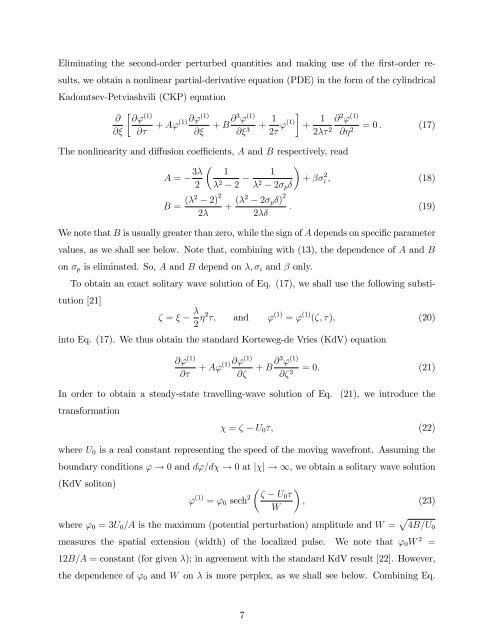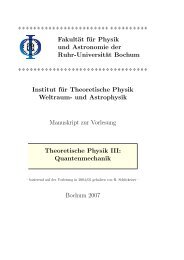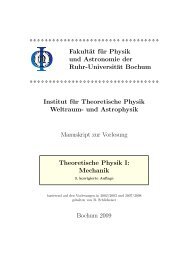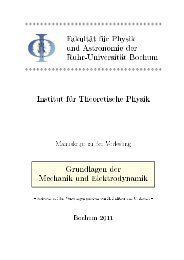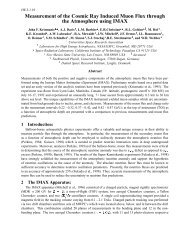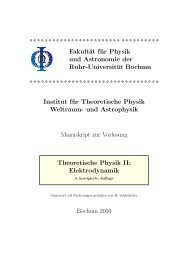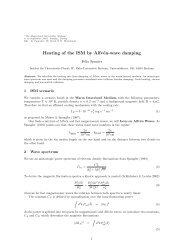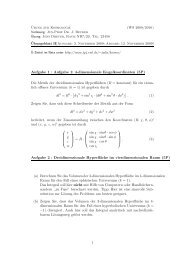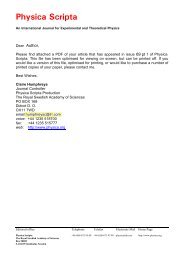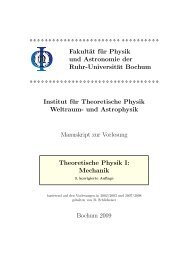pdf here - Theoretische Physik IV - Ruhr-Universität Bochum
pdf here - Theoretische Physik IV - Ruhr-Universität Bochum
pdf here - Theoretische Physik IV - Ruhr-Universität Bochum
Create successful ePaper yourself
Turn your PDF publications into a flip-book with our unique Google optimized e-Paper software.
Eliminating the second-order perturbed quantities and making use of the …rst-order results,<br />
we obtain a nonlinear partial-derivative equation (PDE) in the form of the cylindrical<br />
Kadomtsev-Petviashvili (CKP) equation<br />
<br />
@ @'<br />
(1)<br />
(1) @'(1)<br />
+ A' + B @3 ' (1)<br />
+ 1 <br />
@ @ @ @ 3 2 '(1) + 1 @ 2 ' (1)<br />
= 0 : (17)<br />
2 2 @ 2<br />
The nonlinearity and di¤usion coe¢ cients, A and B respectively, read<br />
A = 3 <br />
1 1<br />
+ <br />
2 2 2 2<br />
i 2 ; (18)<br />
2 p <br />
B = (2 2) 2<br />
2<br />
+ (2 2 p ) 2<br />
2<br />
: (19)<br />
We note that B is usually greater than zero, while the sign of A depends on speci…c parameter<br />
values, as we shall see below. Note that, combining with (13), the dependence of A and B<br />
on p is eliminated. So, A and B depend on ; i and only.<br />
To obtain an exact solitary wave solution of Eq. (17), we shall use the following substitution<br />
[21]<br />
= <br />
<br />
2 2 ; and ' (1) = ' (1) (; ); (20)<br />
into Eq. (17). We thus obtain the standard Korteweg-de Vries (KdV) equation<br />
@' (1)<br />
@<br />
(1) @'(1)<br />
+ A' + B @3 ' (1)<br />
= 0: (21)<br />
@ @ 3<br />
In order to obtain a steady-state travelling-wave solution of Eq.<br />
transformation<br />
(21), we introduce the<br />
= U 0 ; (22)<br />
w<strong>here</strong> U 0 is a real constant representing the speed of the moving wavefront. Assuming the<br />
boundary conditions ' ! 0 and d'=d ! 0 at jj ! 1, we obtain a solitary wave solution<br />
(KdV soliton)<br />
' (1) = ' 0 sech 2 <br />
U0 <br />
W<br />
<br />
; (23)<br />
w<strong>here</strong> ' 0 = 3U 0 =A is the maximum (potential perturbation) amplitude and W = p 4B=U 0<br />
measures the spatial extension (width) of the localized pulse. We note that ' 0 W 2 =<br />
12B=A = constant (for given ); in agreement with the standard KdV result [22]. However,<br />
the dependence of ' 0 and W on is more perplex, as we shall see below. Combining Eq.<br />
7


